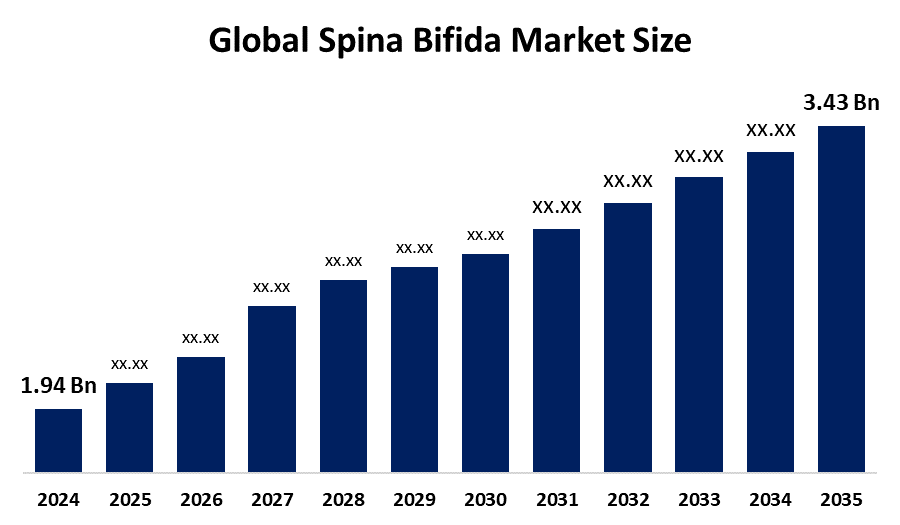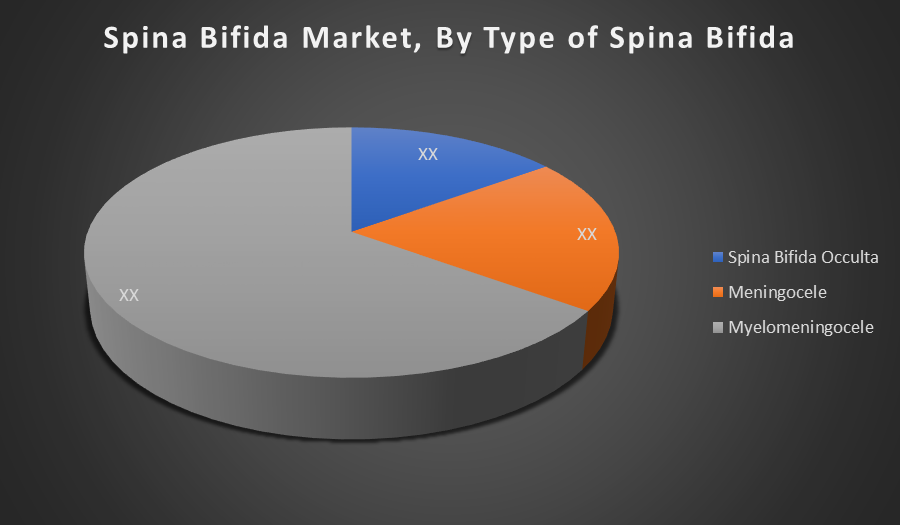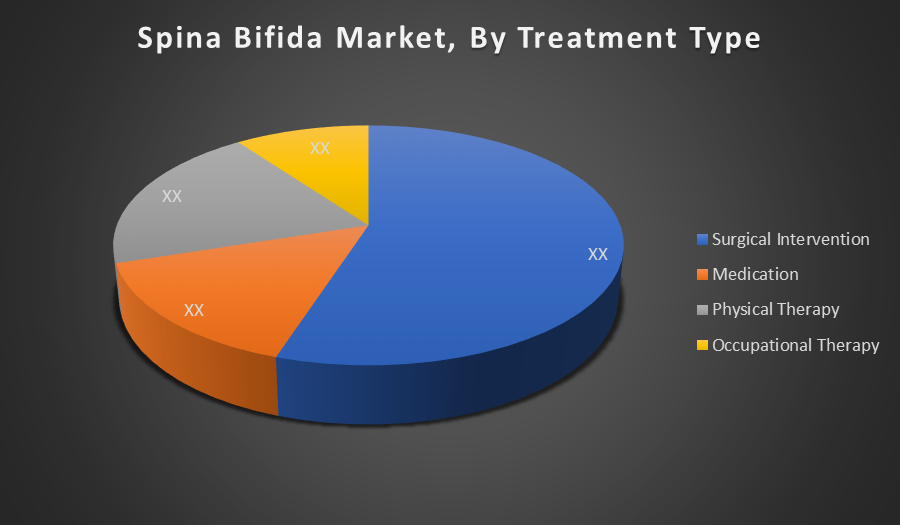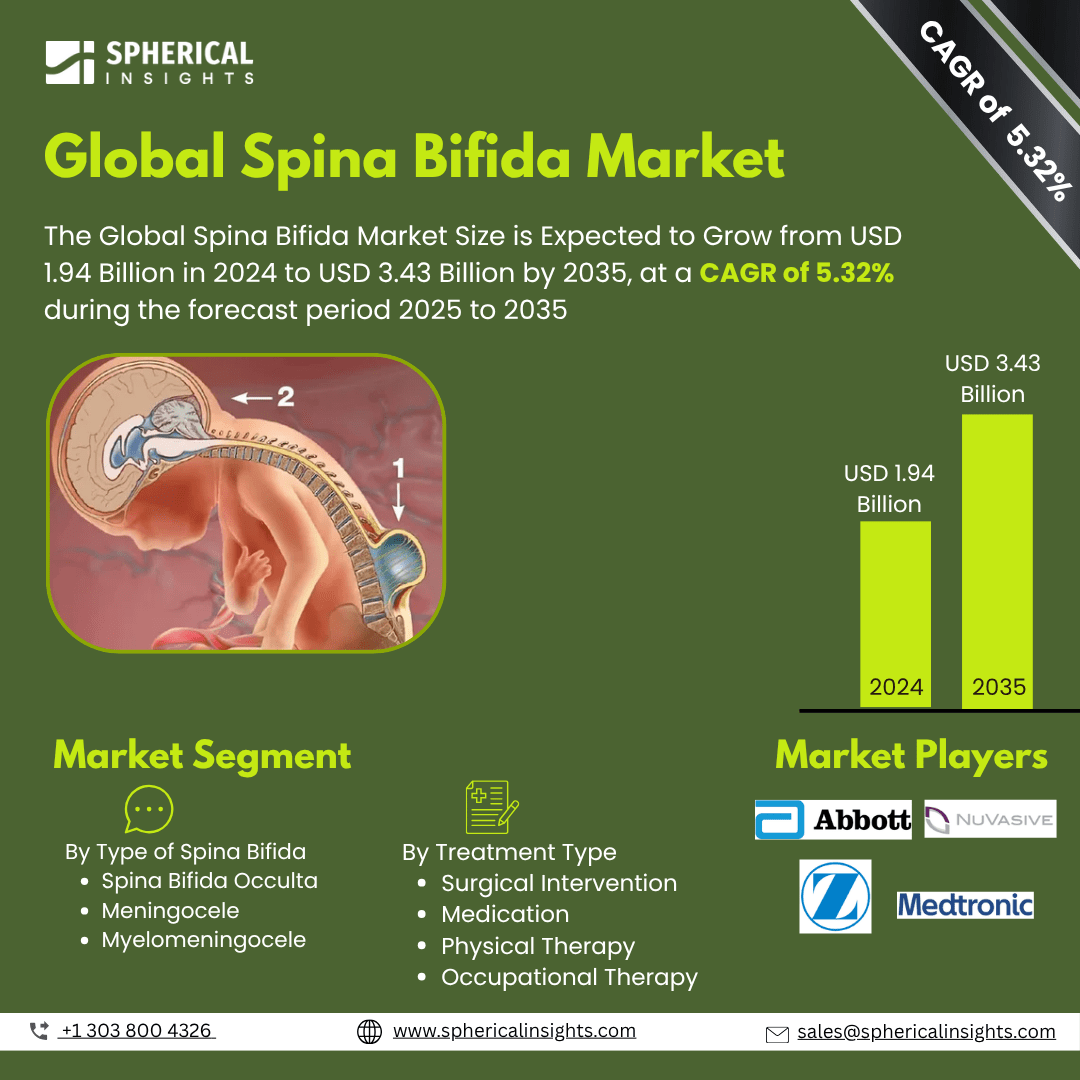- As per Spherical Insights & Consulting, The Global Spina Bifida Market Size is Expected to Grow from USD 1.94 Billion in 2024 to USD 3.43 Billion by 2035, at a CAGR of 5.32% during the forecast period 2025 to 2035, owing to the launch of new therapies in the market and the rise in the number of cases.
- The leading Spina Bifida Market Companies such as Abbott Laboratories, Integra LifeSciences, NuVasive, Zimmer Biomet, Wright Medical Group, Medtronic, BioMimetic Therapeutics, Boston Scientific, Stryker, Orthofix, CONMED Corporation, Smith & Nephew, DePuy Synthes, Globus Medical, Allergan, and Others.

Spina Bifida Treatment Market: Understanding and Treatment Algorithm:
Spina Bifida is a congenital neural tube defect where the spinal column does not close completely during fetal development. This condition can cause varying degrees of physical and neurological impairments, including paralysis and bladder or bowel dysfunction. Early diagnosis and management are crucial to improving patient outcomes.
Spina Bifida Diagnosis:
Spina Bifida is typically diagnosed through prenatal screening methods such as ultrasound and maternal blood tests measuring alpha fetoprotein (AFP). After birth, imaging techniques like MRI and CT scans are used to assess the severity and guide treatment. Early diagnosis helps in planning interventions and reducing complications.
Spina Bifida Treatment:
Treatment for Spina Bifida involves surgical repair to close the spinal defect, along with supportive therapies like physical and occupational therapy. Medications may be used to manage symptoms such as muscle spasticity and bladder dysfunction. Multidisciplinary care improves mobility, independence, and quality of life.
Spina Bifida Epidemiology:
The disease epidemiology covered in the report provides historical as well as forecasted epidemiology segmented by Total Diagnosed Incident Population of Spina Bifida, Gender specific Diagnosed Incidence of Spina Bifida, Type specific Diagnosed Incidence of Spina Bifida, Age specific Diagnosed Incidence of Spina Bifida, Diagnosed Incident Population based on Primary Site of Spina Bifida, and Diagnosed Incident Population based on Histologic Classification of Spina Bifida Tumour in the global market covering North America, Europe, Asia-Pacific, Latin America, the Middle East, and Africa from 2024 to 2035.
Principal Insights:
This section offers a global overview of Spina Bifida epidemiology in major markets worldwide.
Country Wise Spina Bifida Multiforme Epidemiology:
- The epidemiology segment provides Spina Bifida prevalence data and findings across key regions worldwide, including North America, Europe (Germany, France, Italy, Spain, and the United Kingdom), Asia-Pacific (including Japan), Latin America, the Middle East, and Africa.
Spina Bifida Marketed Drugs:
• Baclofen: Allergan
Baclofen is a muscle relaxant that acts on GABA B receptors to reduce spasticity in Spina Bifida patients. It helps manage muscle stiffness and improve mobility. Baclofen is available in oral and intrathecal forms and is widely used to alleviate symptoms associated with neurological impairments.
• Botox: AbbVie
Botox (onabotulinumtoxinA) is a neurotoxin used to treat neurogenic bladder dysfunction in Spina Bifida patients. It temporarily relaxes bladder muscles to improve urinary control and reduce incontinence. Botox is FDA approved for managing bladder dysfunction related to neurological disorders.
Spina Bifida: Emerging Therapies:
- SB 101: SB 101 is an investigational stem cell therapy aimed at repairing damaged neural tissue in Spina Bifida patients. It focuses on regenerating spinal cord cells to improve motor function and reduce neurological deficits. Currently in clinical trials, SB 101 represents a novel regenerative approach beyond traditional treatments.
- NT 200: NT 200 is a gene therapy candidate targeting the genetic causes of Spina Bifida. By delivering corrected gene sequences to affected spinal cord cells, it aims to prevent further damage and promote normal development. This therapy is in preclinical development and shows promise for addressing the root causes of the disorder.
Spina Bifida Market Outlook:
- The Spina Bifida market encompasses diagnostic, treatment, and rehabilitation products and services for managing Spina Bifida, a congenital neural tube defect affecting the spine and spinal cord, aiming to improve patient quality of life through surgical, medical, and therapeutic interventions.
- Rising prevalence of Spina Bifida, advancements in surgical and diagnostic technologies, growing awareness about early diagnosis, and increasing healthcare expenditure globally are key drivers boosting demand for effective treatment and management solutions.
- Emerging markets with improving healthcare infrastructure, innovation in minimally invasive surgeries, development of novel therapeutic approaches, and increasing investments in research offer substantial growth opportunities for market players.
- Governments worldwide are promoting prenatal screening programs, funding neural tube defect research, and raising awareness about folic acid supplementation to reduce Spina Bifida incidence and improve patient care outcomes.
- High treatment costs and limited access to advanced healthcare in low-income regions restrict market growth.
- The market is projected to grow steadily due to increasing awareness, technological advancements, and expanding healthcare access worldwide.
Spina Bifida Market Segmentation:
By Type of Spina Bifida:
- Spina Bifida Occulta
- Meningocele
- Myelomeningocele

The Myelomeningocele segment holds the largest market share because it is the most severe and common form of spina bifida. It causes significant neurological impairment, leading to greater demand for treatment and management options compared to Spina Bifida Occulta and Meningocele, which are milder or less symptomatic.
By Treatment Type:
- Surgical Intervention
- Medication
- Physical Therapy
- Occupational Therapy

The Surgical Intervention segment dominates the market share as surgery is often essential to correct spinal defects, prevent further complications, and improve quality of life. Other treatments like medication and therapies are supportive, but surgery addresses the core structural issues directly, driving higher market demand.
Regional Segment Analysis of the Spina Bifida Market:
North America holds the largest share in the Spina Bifida market due to advanced healthcare infrastructure, high awareness levels, and significant government funding for congenital disorder research. The presence of well-established healthcare facilities and a large patient base seeking specialized treatment options further drives market dominance. Additionally, early diagnosis and widespread use of advanced surgical and therapeutic interventions contribute to its leading position.
The Asia Pacific region is the fastest growing market for Spina Bifida due to increasing healthcare investments, rising awareness, and improving diagnostic capabilities. Growing government initiatives to improve maternal and child health, along with expanding healthcare infrastructure in emerging economies like India and China, fuel market growth. Additionally, a large population base and improving access to advanced treatments are accelerating demand in this region.
Spina Bifida Market Key Companies:
- Abbott Laboratories
- Integra LifeSciences
- NuVasive
- Zimmer Biomet
- Wright Medical Group
- Medtronic
- BioMimetic Therapeutics
- Boston Scientific
- Stryker
- Orthofix
- CONMED Corporation
- Smith & Nephew
- DePuy Synthes
- Globus Medical
- Allergan
- Others
Market Segment:
This study forecasts revenue at the global, regional, and country levels from 2020 to 2035. Spherical Insights has segmented the Spina Bifida market based on the following segments:
Global Spina Bifida Market, By Type of Spina Bifida
- Spina Bifida Occulta
- Meningocele
- Myelomeningocele
Global Spina Bifida Market, By Treatment Type
- Surgical Intervention
- Medication
- Physical Therapy
- Occupational Therapy
Global Spina Bifida Market, By Regional Analysis
- North America
- Europe
- Germany
- UK
- France
- Italy
- Spain
- Russia
- Rest of Europe
- Asia Pacific
- China
- Japan
- India
- South Korea
- Australia
- Rest of Asia Pacific
- South America
- Brazil
- Argentina
- Rest of South America
- Middle East & Africa
- UAE
- Saudi Arabia
- Qatar
- South Africa
- Rest of the Middle East & Africa






